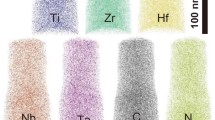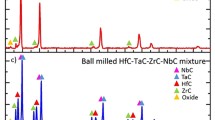Abstract
In order to prepare high toughness (Ti,Zr,Nb,Ta,Mo)C ceramics at low temperatures while maintaining high hardness, a liquid-phase sintering process combined with Co-based liquid-phase extrusion strategy was adopted in this study. The densification temperature can be lowered to 1350 °C, which is much lower than the solid-state sintering temperature (∼2000 °C) generally employed for high-entropy carbide ceramics. When sintered at 1550 °C and 30 MPa applied pressure, part of the Co-based liquid-phase was squeezed out of the graphite mold, such that only ∼3.21 vol% of Co remained in the high-entropy ceramic. Compared to the Co-free solid-state sintered (Ti,Zr,Nb,Ta,Mo)C ceramics, prepared at 2000 °C and 35 MPa, the hardness was slightly decreased from 25.06±0.32 to 24.11±0.75 GPa, but the toughness was increased from 2.25±0.22 to 4.07±0.13 MPa·m1/2. This work provides a new strategy for low-temperature densification of high-entropy carbides with both high hardness and high toughness.
Article PDF
Similar content being viewed by others
Avoid common mistakes on your manuscript.
References
Xiang HM, Xing Y, Dai FZ, et al. High-entropy ceramics: Present status, challenges, and a look forward. J Adv Ceram 2021, 10: 385–441.
Luo SC, Guo WM, Plucknett K, et al. Fine-grained dual-phase high-entropy ceramics derived from boro/carbothermal reduction. J Eur Ceram Soc 2021, 41: 3189–3195.
Sarker P, Harrington T, Toher C, et al. High-entropy high-hardness metal carbides discovered by entropy descriptors. Nat Commun 2018, 9: 4980.
Feng L, Chen WT, Fahrenholtz WG, et al. Strength of single-phase high-entropy carbide ceramics up to 2300 °C. J Am Ceram Soc 2021, 104: 419–427.
Chen H, Xiang HM, Dai FZ, et al. High porosity and low thermal conductivity high entropy (Zr0.2Hf0.2Ti0.2Nb0.2Ta0.2)C. J Mater Sci Technol 2019, 35: 1700–1705.
Sun QC, Tan H, Zhu SY, et al. Single-phase (Hf—Mo—Nb—Ta—Ti)C high-entropy ceramic: A potential high temperature anti-wear material. Tribol Int 2021, 157: 106883.
Luo SC, Guo WM, Zhou YZ, et al. Textured and toughened high-entropy (Ti0.2Zr0.2Hf0.2Nb0.2Ta0.2)C—SiCw ceramics. J Mater Sci Technol 2021, 94: 99–103.
Castle E, Csanádi T, Grasso S, et al. Processing and properties of high-entropy ultra-high temperature carbides. Sci Rep 2018, 8: 8609.
Dusza J, Švec P, Girman V, et al. Microstructure of (Hf—Ta—Zr—Nb)C high-entropy carbide at micro and nano/atomic level. J Eur Ceram Soc 2018, 38: 4303–4307.
Yan XL, Constantin L, Lu YF, et al. (Hf0.2Zr0.2Ta0.2Nb0.2Ti0.2)C high-entropy ceramics with low thermal conductivity. J Am Ceram Soc 2018, 101: 4486–4491.
Feng L, Fahrenholtz WG, Hilmas GE. Low-temperature sintering of single-phase, high-entropy carbide ceramics. J Am Ceram Soc 2019, 102: 7217–7224.
Wang K, Chen L, Xu CG, et al. Microstructure and mechanical properties of (TiZrNbTaMo)C high-entropy ceramic. J Mater Sci Technol 2020, 39: 99–105.
Wen TQ, Ye BL, Nguyen MC, et al. Thermophysical and mechanical properties of novel high-entropy metal nitride-carbides. J Am Ceram Soc 2020, 103: 6475–6489.
Pötschke J, Dahal M, Herrmann M, et al. Preparation of high-entropy carbides by different sintering techniques. J Mater Sci 2021, 56: 11237–11247.
Yu D, Yin J, Zhang BH, et al. Pressureless sintering and properties of (Hf0.2Zr0.2Ta0.2Nb0.2Ti0.2)C high-entropy ceramics: The effect of pyrolytic carbon. J Eur Ceram Soc 2021, 41: 3823–3831.
Yu D, Zhang BH, Yin J, et al. Densifying (Hf0.2Zr0.2Ta0.2Nb0.2Ti0.2)C high-entropy ceramics by two-step pressureless sintering. J Am Ceram Soc 2022, 105: 76–81.
Ma MD, Sun YN, Wu YJ, et al. Nanocrystalline high-entropy carbide ceramics with improved mechanical properties. J Am Ceram Soc 2022, 105: 606–613.
Huang SG, Van der Biest O, Li L, et al. Properties of NbC—Co cermets obtained by spark plasma sintering. Mater Lett 2007, 61: 574–577.
Grathwohl G, Warren R. The effect of cobalt content on the microstructure of liquid-phase sintered TaC—Co alloys. Mater Sci Eng 1974, 14: 55–65.
Miller DJ, Pask JA. Liquid-phase sintering of TiC—Ni composites. J Am Ceram Soc 1983, 66: 841–846.
Zamora V, Guiberteau F, Borrero-López O, et al. Spark plasma sintering and dry sliding-wear of ZrC—16.7 vol.% Co cemented carbides. Ceram Int 2021, 47: 12803–12811.
Pötschke J, Dahal M, Vornberger A, et al. Production and properties of high entropy carbide based hardmetals. Metals 2021, 11: 271.
Liu JB, Xiong J, Guo ZX, et al. Preparation of high-entropy (Zr0.25Hf0.25Ta0.25Ti0.25)C—Ni—Co composite by spark plasma sintering. Metall Mater Trans A 2020, 51: 6706–6713.
Evans AG, Charles EA. Fracture toughness determinations by indentation. J Am Ceram Soc 1976, 59: 371–372.
Oliver CJRG, Álvarez EA, García JL. Kinetics of densification and grain growth in ultrafine WC—Co composites. Int J Refract Met Hard Mater 2016, 59: 121–131.
Kim SI, Lee KH, Mun HA, et al. Dense dislocation arrays embedded in grain boundaries for high-performance bulk thermoelectrics. Science 2015, 348: 109–114.
Naidoo M, Johnson O, Sigalas I, et al. Influence of tantalum on the microstructure and properties of Ti(C,N)—Ni cermets. Int J Refract Met Hard Mater 2014, 42: 97–102.
Wen G, Li SB, Zhang BS, et al. Processing of in situ toughened B—W—C composites by reaction hot pressing of B4C and WC. Scripta Mater 2000, 43: 853–857.
Jam A, Nikzad L, Razavi M. TiC-based cermet prepared by high-energy ball-milling and reactive spark plasma sintering. Ceram Int 2017, 43: 2448–2455.
Vallauri D, Deorsola FA. Synthesis of TiC—TiB2—Ni cermets by thermal explosion under pressure. Mater Res Bull 2009, 44: 1528–1533.
Genga RM, Cornish LA, Akdogan G. Effect of Mo2C additions on the properties of SPS manufactured WC—TiC—Ni cemented carbides. Int J Refract Met Hard Mater 2013, 41: 12–21.
Graziani T, Bellosi A. Densification and characteristics of TiN ceramics. J Mater Sci Lett 1995, 14: 1078–1081.
Wang F, Zhang X, Yan XL, et al. The effect of submicron grain size on thermal stability and mechanical properties of high-entropy carbide ceramics. J Am Ceram Soc 2020, 103: 4463–4472.
Acknowledgements
This work was supported by the National Natural Science Foundation of China (Grant Nos. 51832002, 51402055, 51602060, and U1401247) and the Science and Technology Program of Guangzhou (Grant No. 201704030095).
Author information
Authors and Affiliations
Corresponding authors
Rights and permissions
Open Access This article is licensed under a Creative Commons Attribution 4.0 International License, which permits use, sharing, adaptation, distribution and reproduction in any medium or format, as long as you give appropriate credit to the original author(s) and the source, provide a link to the Creative Commons licence, and indicate if changes were made.
The images or other third party material in this article are included in the article’s Creative Commons licence, unless indicated otherwise in a credit line to the material. If material is not included in the article’s Creative Commons licence and your intended use is not permitted by statutory regulation or exceeds the permitted use, you will need to obtain permission directly from the copyright holder.
To view a copy of this licence, visit http://creativecommons.org/licenses/by/4.0/.
About this article
Cite this article
Luo, SC., Guo, WM., Plucknett, K. et al. Low-temperature densification of high-entropy (Ti,Zr,Nb,Ta,Mo)C—Co composites with high hardness and high toughness. J Adv Ceram 11, 805–813 (2022). https://doi.org/10.1007/s40145-022-0574-6
Received:
Revised:
Accepted:
Published:
Issue Date:
DOI: https://doi.org/10.1007/s40145-022-0574-6




